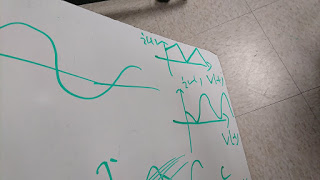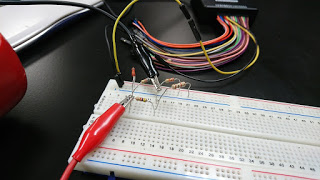1. Provide the initial capacitor voltages and time constants for the circuits
2. Provide below a schematic of the circuit you implemented, including actual resistance and capacitance values used in your circuit. A picture of your whiteboard sketch is adequate.
This is the actual circuit we built during the experiment:
The actual resistance for R1 = 0.977 ohms and R2 = 2.16k ohms.
3. Attach an image of the oscilloscope window,showing the capacitor voltage response for the circuit of Figure2(a)
from the graph we measured 5 time constant = 0.343s
And from the pre-lan we calculated 5 time constant = 0.352s
% error = (0.352-0.343)/0.343*100% = 2.56%
Figure 2(b)
From the graph we measured 5 time constant = 0.08158s
From the pre-lab we calculated 5 time constant = 0.0756s
% error = (0.08158-0.0756)/0.08158*100% = 7.91%
Summary
In today's class, we were learning how to find the equivalent for the capacitor and inductor. For the inductor, it is the same as the resistance when inductors are in parallel and series. However, the capacitor is in the inverse. Also, we learned two equations for the inductor and capacitor:
The follow photo is the example we did during the class:
















































